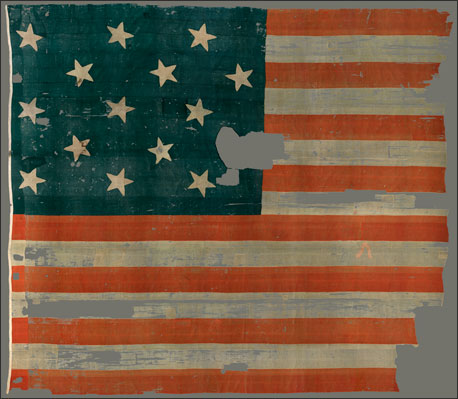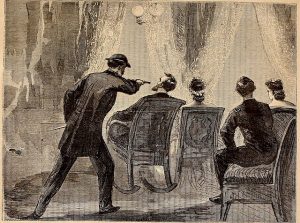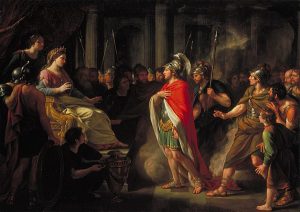Francis Scott Key was born on August 1, 1779 in Terra Rubra, Maryland. After graduating college, Key began to study law in hopes of becoming an attorney.1 Soon after, Keys got married and had eleven children and moved to Georgetown where he started his own practice.2 Key became very successful in his work as a lawyer, and for hobbies he sang for the church and wrote poems, a lot of which are still appreciated today. When the War of 1812 broke out, Key enlisted in the US army.3

Francis Scott Key was sent to a British ship to negotiate the release of certain prisoners. Upon Key’s arrival to the ship, he showed the Commodore of the ship letters from British troops that had been captured by American forces.4 The letters explained how well they were being treated and that they were not harmed in any way. After seeing this, the Commodore let their prisoner William Beanes free, but before the three American men could leave, the British troops were preparing to attack Fort McHenry, and therefore needed to keep them on the ship so that they would not be able to return back to warn the American troops.5
For over twenty-four hours the two sides, American and British, exchanged fire. The British recorded that “over eight hundred shells” were shot at the fort.6 After twenty-four hours of fighting both on land and sea, Francis Scott Key waited for the smoke to clear and saw that the American flag at Fort McHenry was still waving high. Key immediately began to write a poem on what he had witnessed that day. The poem quickly rose to fame and gained the attention of almost every single American.7
Very few people know that the poem went through different phases before becoming the American National Anthem. The original title of the poem was “The Defense of Fort McHenry.” Key later added the tune from an old drinking song called “To Anacreon in Heaven.”8 Later, Congress met to decide on a song for the nation; all songs were rejected, including “The Defense on Fort McHenry.” People that opposed the song claimed that the lyrics were too difficult to sing, it was not martial enough, and it was only about one event in all of American history.9 People who supported the song loved that the lyrics were difficult; that way only professional musicians and singers could sing it before certain important occasions.10
It was not until 1916 that the United States made the “The Star-Spangled Banner” the unofficial nation anthem. Woodrow Wilson was asked to have a “ceremonial song” for the United States, so he picked the most loved song by the people of the United States.11 But it was not until 1931 that Congress adopted the “The Star-Spangled Banner” as the official nation anthem of America. The poem was seen and adored by Americans for the patriotism it stood for and as a reminder of its past victories. This song is now sung before almost every major event in the United States to serve as a reminder of America’s victory against all odds.12
While the first stanza of the poem is widely known and sung today, few have been able to appreciate it in its entirety. Here, then, is the original poem:
O say can you see, by the dawn’s early light,
What so proudly we hail’d at the twilight’s last gleaming,
Whose broad stripes and bright stars through the perilous fight
O’er the ramparts we watch’d were so gallantly streaming?
And the rocket’s red glare, the bomb bursting in air,
Gave proof through the night that our flag was still there,
O say does that star-spangled banner yet wave
O’er the land of the free and the home of the brave?
On the shore dimly seen through the mists of the deep
Where the foe’s haughty host in dread silence reposes,
What is that which the breeze, o’er the towering steep,
As it fitfully blows, half conceals, half discloses?
Now it catches the gleam of the morning’s first beam,
In full glory reflected now shines in the stream,
‘Tis the star-spangled banner – O long may it wave
O’er the land of the free and the home of the brave!
And where is that band who so vauntingly swore,
That the havoc of war and the battle’s confusion
A home and a Country should leave us no more?
Their blood has wash’d out their foul footstep’s pollution.
No refuge could save the hireling and slave
From the terror of flight or the gloom of the grave,
And the star-spangled banner in triumph doth wave
O’er the land of the free and the home of the brave.
O thus be it ever when freemen shall stand
Between their lov’d home and the war’s desolation!
Blest with vict’ry and peace may the heav’n rescued land
Praise the power that hath made and preserv’d us a nation!
Then conquer we must, when our cause it is just,
And this be our motto – “In God is our trust,”
And the star-spangled banner in triumph shall wave
O’er the land of the free and the home of the brave.13
- War of 1812, 2002, s.v. “Key, Francis Scott.” ↵
- War of 1812, 2002, s.v. “Key, Francis Scott.” ↵
- War of 1812, 2002, s.v. “Key, Francis Scott.” ↵
- War of 1812, 2002, s.v. “Key, Francis Scott.” ↵
- UXL Encyclopedia of U.S. History, 2009, s.v. “The Star-Spangled Banner,” by Sonia Benson, Daniel E. Brannen, Jr., and Rebecca Valentine. ↵
- UXL Encyclopedia of U.S. History, 2009, s.v. “The Star-Spangled Banner,” by Sonia Benson, Daniel E. Brannen, Jr., and Rebecca Valentine. ↵
- UXL Encyclopedia of U.S. History, 2009, s.v. “The Star-Spangled Banner,” by Sonia Benson, Daniel E. Brannen, Jr., and Rebecca Valentine. ↵
- “Key, Francis Scott,” in Shaping of America, 1783-1815 Reference Library, edited by Lawrence W. Baker, Richard C. Hanes, Sharon M. Hanes, and Kelly Rudd, Vol. 2, Biographies Volume 1, 257. ↵
- “Key, Francis Scott,” in Shaping of America, 1783-1815 Reference Library, edited by Lawrence W. Baker, Richard C. Hanes, Sharon M. Hanes, and Kelly Rudd, Vol. 2, Biographies Volume 1, 258. ↵
- “Key, Francis Scott.” In Shaping of America, 1783-1815 Reference Library, edited by Lawrence W. Baker, Richard C. Hanes, Sharon M. Hanes, and Kelly Rudd, . Vol. 2, Biographies Volume 1,258. ↵
- “Key, Francis Scott.” In Shaping of America, 1783-1815 Reference Library, edited by Lawrence W. Baker, Richard C. Hanes, Sharon M. Hanes, and Kelly Rudd, Vol. 2, Biographies Volume 1,258. ↵
- UXL Encyclopedia of U.S. History, 2009 s.v. “The Star-Spangled Banner,” by Benson, Sonia, Daniel E. Brannen, Jr., and Rebecca Valentine. ↵
- Francis Scott Key, “The Star-Spangled Banner” (wording of the original handwritten manuscript, in the Museum Department of the Maryland Historical Society). ↵



101 comments
Mariah Cavanaugh
This was an incredibly informative article. I didn’t realize how little I knew about the history of The Star-Spangled Banner. It is remarkable that a simple poem written on the battlefield morphed into a song that when heard instills a sense of patriotism within Americans. I love the fact that he added a tune from a drinking song. What is more American than patriotism and drinking?
Michelle Falcon
This was an amazing article! I never knew the history of the national anthem, such as who was the person that wrote it or what it was written about. I also had no idea that there were other verses to it than just the one that we all know. This song has had such an impact on our lives, even if it wasn’t something you hear to often. You are certainly able to hear it at sports games and other events like that. I learned so much from this article, I very much so enjoyed reading it.
Ryann Cervantes
I knew that Key was captured and wrote the song after having been kept prisoner and seeing that the British lost the battle. However, I didn’t know he was only captured so he wouldn’t reveal the British’s plans or that he himself was a soldier. What a fitting anthem for our nation. A poem written by a soldier, while being captured, and awakening to the flying flag of a victorious America.
Josselyn Arrieta-Meraz
I knew a little about the history of the star spangled banner, but this was a great refresher, a song that is always present in special occasions, and most defiantly is hard to sing depending on the individual. I loved how you included the original poem, to think it all started from a poem that was rejected many times and a specific event that now highlights the history of our nation.
Maria Callejas
This was a great article topic! Although this the most known song in the United States, most of us here know little information on its origins. You provide great insight into the author’s life, without spending too much time on that. I had no idea it was until 1931 that the Star Spangled Banner became the official US anthem. Great way to finish your article, I had no idea the original poem contained more stanzas, as I am sure most of the readers also felt. Indeed this song will live through time, assuring the greatness of the United States. Great job!
Michael Mandujano
This article is very interesting and worth the read. The illustrations that were depicted throughout this article are amazing. I enjoyed how this article provided historical information on how Francis Scott Key composed the Star-Spangled Banner. I also enjoyed this article because it allows readers to perfectly experience how the placement of the flag through the ashes and smoke influenced the creation of our National Anthem. Overall, it was neat how this article included the original poem of the Star-Spangled Banner.
Carlos Aparicio
The most important feature about this article is the information that was presented. It’s good to know and appreciate where our nation once stood. I admire how Luke gave background about Scott Key and then made a smooth transition to how the poem was born. I personally never knew that the song was written after the battle between the British and Americans and that it was originally called “The Defense of Fort McHenry”.
Alejandra Chavez
I had always thought that the star spangled banner was around almost as long as the declaration of independence. It’s unnerving yet fascinating to know that it’s only been official for not even a century. I was also unaware of how long the initial song is since I have grown in an era where it’s been shortened. I was surprised to find out that the writer was a lawyer who enlisted into the military and simply wrote a poem depicting what he saw.
Mario Sosa
This article was full of surprising facts that I was unaware of! I had a feeling that the version of the song we hear all the time is shortened, but I did not think the song was overly long. I found it strange that it took so long (almost 120 years) for the song to finally be recognized as the official national anthem. Good job on the article, nicely done!
Mariet Loredo
Great article! I had no clue that the Star Spangle Banner had more versus. Being an American I feel that I should know the history of the Star Spangle Banner like the back of my hand. I find it very interesting that Francis Scott Key wrote the Star Spangle Banner right after the attack on Forth McHenry, because he was inspired by the American flag still standing even after the attack.